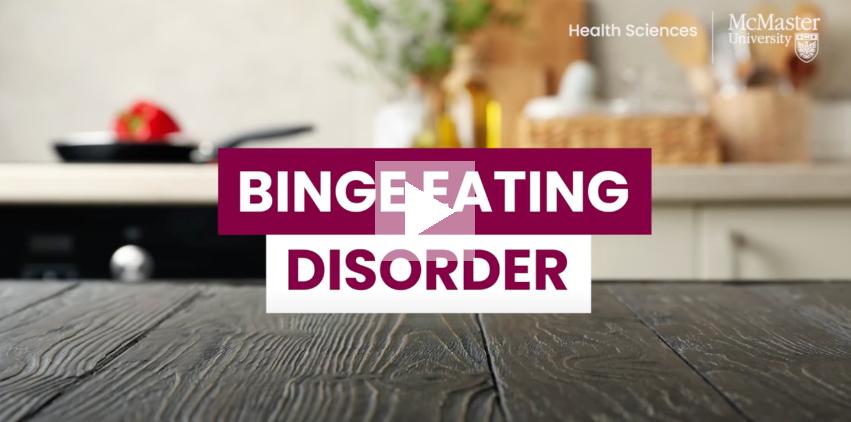⏱ 3 min read, 2 min video
Many people have difficulties with binge eating at some point in their lives, and it is estimated that it affects up to 5% of the population. It is experienced by people of all ages, genders, socioeconomic classes, racial backgrounds, and ethnicities. Binge eating disorder is about twice as common in females than males, and it may affect about 20% of women aged 60 and over.1 It is more common in men compared with other eating disorders, and likely underreported.
Any eating disorder can have a negative impact on healthy aging.
In this 2-minute video, psychiatrist Dr. Jennifer Couturier explains the symptoms of binge eating disorder, its emotional impact, common misconceptions, potential treatments, and the importance of psychotherapy.

Download a transcript of this video.
What is binge eating disorder?
Binge eating disorder (BED) is a recognized eating disorder where individuals frequently consume large amounts of food in a short period of time (eg, within any 2-hour period). There is a sense of lack of control while eating – either a feeling that you can’t stop eating or control what or how much you’re eating. This behaviour is often accompanied by at least three of the following symptoms:2
- Eating very quickly
- Eating until feeling uncomfortably full
- Eating even when not feeling physically hungry
- Eating alone because of feeling embarrassed about how much one is eating, or
- Experiencing feelings of self-disgust, guilt, or depression after eating
People with BED experience significant distress about their eating habits. Unlike other eating disorders, such as bulimia nervosa and anorexia nervosa, binge eating episodes are not typically followed by compensatory behaviours like vomiting, use of laxatives, or excessive exercise.
Causes and risk factors
Binge eating disorder (BED) is influenced by a combination of biological, psychological, and social factors.3
Biological factors: Research suggests that genetics and early life experiences, such as childhood trauma, may contribute to emotional difficulties that lead to binge eating. Additionally, BED is linked to brain function, particularly in the reward system. Individuals with BED may have a low level of dopamine, a chemical that affects pleasure, making them more sensitive to the rewarding aspects of food.
Psychological factors: Emotional regulation plays a significant role in BED. People with BED often struggle to manage their emotions and may turn to binge eating as a way to cope with negative feelings. Although this provides temporary relief, it often leads to feelings of guilt and distress, which can trigger further binge eating, creating a vicious cycle.
Social factors: The cognitive behavioural model highlights the impact of societal pressures and personal attempts to control weight through strict dieting. This rigid dietary restraint can lead to binge eating episodes, which then cause feelings of shame and guilt, perpetuating the cycle of binge eating and dieting.
Signs and symptoms
People with BED may experience physical symptoms such as:4
- Unusual weight changes
- Bloating
- Frequent stomach aches
- Constipation
They may also experience behaviours such as:
- Skipping meals
- Avoiding eating with others
- Eating in secret
- Hiding food
- Withdrawing from social activities
Mood changes may include:
- Increased anxiousness
- Increased irritability
- Low mood or depression
Health consequences of BED
BED is associated with many physical health conditions, including obesity, diabetes, heart disease, chronic pain, and sleep problems. It can result in poor nutritional intake, as foods associated with binge episodes are typically high in sugar, fat and salt. The mental health impacts include depression, anxiety, and poor quality of life.
In older adults, the health consequences of any form of disordered eating may be even more severe than seen in the general population, as older adults may already be at risk of over- or under-nutrition, sarcopenia (loss of muscle mass), and frailty.5
Treatment options
Psychotherapy
The primary treatment for BED involves psychotherapy, and many people can have success with guided self-help, which can include books and apps, supported by brief sessions of support from a healthcare professional.
Individual psychotherapy, in the form of cognitive behavioural therapy (CBT) or dialectical behavioural therapy (DBT), may be appropriate for some people.
CBT helps individuals understand the relationship between their thoughts, feelings, and behaviours. In the case of BED, CBT focuses on identifying and changing negative thought patterns and behaviours related to food and body image. It also teaches skills to manage stress and regulate emotions, which can reduce the urge to binge eat.
DBT combines cognitive-behavioural techniques with mindfulness practices. It helps individuals develop skills to cope with distress, improve emotional regulation, and build healthier relationships. DBT is particularly useful for those who struggle with intense emotions and impulsive behaviours.
Medication strategies
In addition to psychotherapy, some individuals may benefit from medications that target underlying issues such as depression or anxiety. However, the use of medications should be carefully monitored by healthcare professionals due to potential risks and side effects, especially in older adults.
Other supports
Dietitians with eating disorders training can offer guidance on healthy eating patterns, emotional support, and strategies to prevent relapse.
Overall, a combination of therapy, medical support, and lifestyle changes can significantly improve the quality of life for individuals with BED.
Tell us what you think of this content by completing this 2-question survey.



_jpg.jpg?sfvrsn=bcb0dd6_2)


